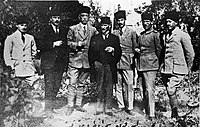Benutzer:Kurator71/Sivas Congress

The Sivas Congress (Vorlage:Lang-tr) was an assembly of the Turkish National Movement held for one week from 4 to 11 September 1919 in the city of Sivas,[1] in central-eastern Turkey, that united delegates from all Anatolian provinces of the Ottoman Empire,[2] which was defunct at the time in practical terms. At the time of the convention, the state capital (Constantinople) as well as many provincial cities and regions were under occupation. The call for the congress had been issued by Mustafa Kemal Atatürk with his Amasya Circular three months before and the preparatory work had been handled during Erzurum Congress.[1] The congress at Sivas took a number of vital decisions which were fundamentally to shape the future policy to be conducted in the frame of the Turkish War of Independence.
Although smaller than the Erzurum Congress (with 38 delegates), the delegates came from a wider geographical area than was the case with the Erzurum Congress.[2] Along with the Erzurum Congress, the Sivas Congress determined the main points of the Misak-ı Millî (National Pact) that the Turkish National Movement made with other Turkish resistance movements against the Allies to work together, namely the imperial government in Constantinople.[3] The two bodies signed the Amasya Protocol the next month on 22 October 1922, calling for new elections after which the Ottoman Chamber of Deputies would consider the agreements of the Sivas Congress.[3] Once word reached the occupying Allies in Constantinople, however, they dissolved the parliament, after which the remaining vestiges of the Ottoman imperial government would become antagonistic against the Turkish National Movement in Ankara.[3]
References[Bearbeiten | Quelltext bearbeiten]
Vorlage:Wikisourcelang Vorlage:Reflist
Vorlage:Turkish War of Independence Vorlage:Republican People's Party Conventions Kategorie:Turkish War of Independence Kategorie:History of Sivas Kategorie:Sivas Vilayet Kategorie:1919 in the Ottoman Empire Kategorie:1919 conferences
- ↑ a b Metin Heper, Nur Bilge Criss: Historical Dictionary of Turkey. Scarecrow Press, 2009, ISBN 978-0-8108-6281-4, S. 277 (google.com).
- ↑ a b Kate Fleet, Suraiya Faroqhi, Reşat Kasaba: The Cambridge History of Turkey. Cambridge University Press, 2006, ISBN 978-0-521-62096-3, S. 125 (google.com).
- ↑ a b c William Hale: Turkish Foreign Policy, 1774-2000. Routledge, 2012, ISBN 978-1-136-23802-4, S. 33 (google.com).